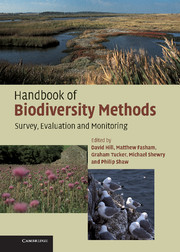Book contents
- Frontmatter
- Contents
- Preface
- Acknowledgements
- Part I Planning
- Part II Habitats
- Part III Species
- 9 Introduction to species assessment
- 10 General principles and methods for species
- 11 Fungi
- 12 Lichens
- 13 Bryophytes
- 14 Aquatic macrophytes and algae
- 15 Vascular plants
- 16 Dragonflies and damselflies
- 17 Butterflies
- 18 Moths
- 19 Other terrestrial invertebrates
- 20 Aquatic invertebrates
- 21 Fish
- 22 Amphibians
- 23 Reptiles
- 24 Birds
- 25 Bats
- 26 Other mammals
- Appendix 1 Monitoring and reporting obligations under international conservation agreements
- Appendix 2 Relationship between BAP Priority Habitat and Broad Habitat categories and Habitats Directive nomenclature
- Appendix 3 Annotated list of key references for plant identification
- Appendix 4 Determining appropriate quadrat size for vegetation sampling
- Appendix 5 The relocation of permanent plots
- Appendix 6 Equipment required for undertaking different types of survey
- Recommended sources of further information
- References
- Glossary
- Index
10 - General principles and methods for species
Published online by Cambridge University Press: 01 September 2010
- Frontmatter
- Contents
- Preface
- Acknowledgements
- Part I Planning
- Part II Habitats
- Part III Species
- 9 Introduction to species assessment
- 10 General principles and methods for species
- 11 Fungi
- 12 Lichens
- 13 Bryophytes
- 14 Aquatic macrophytes and algae
- 15 Vascular plants
- 16 Dragonflies and damselflies
- 17 Butterflies
- 18 Moths
- 19 Other terrestrial invertebrates
- 20 Aquatic invertebrates
- 21 Fish
- 22 Amphibians
- 23 Reptiles
- 24 Birds
- 25 Bats
- 26 Other mammals
- Appendix 1 Monitoring and reporting obligations under international conservation agreements
- Appendix 2 Relationship between BAP Priority Habitat and Broad Habitat categories and Habitats Directive nomenclature
- Appendix 3 Annotated list of key references for plant identification
- Appendix 4 Determining appropriate quadrat size for vegetation sampling
- Appendix 5 The relocation of permanent plots
- Appendix 6 Equipment required for undertaking different types of survey
- Recommended sources of further information
- References
- Glossary
- Index
Summary
INTRODUCTION
This section describes some general principles and methods that are applicable to many of the species groups covered in Chapters 11-26. Methods have been divided into several broad groups. These include total counts and methods that sample species over defined areas or periods of time or both. There is, however, some overlap between them. For example, quadrats may be sampled along a transect; fixed-radius point counts can be construed as circular quadrats. Where necessary, the reader will be referred to the relevant chapters.
Methods may be loosely divided into those for sedentary species and those for mobile species. Sedentary species are often easier to sample. Quadrats may be used because, given enough time, all the individuals in a sample area can be counted. In contrast, mobile species may flee from observers.
When sampling an area for mobile species, it is necessary to obtain a ‘snapshot’ of how many individuals exist in that area before they move significantly, or react to the presence of the observer. For a strip transect, density can be estimated by dividing the number of individuals seen by the area of the transect. However, this estimate will be biased downwards if you are more likely to miss individuals that are further away from you as you make the observations.
If it is likely that individuals are being missed then it is worth considering distance sampling methods.
- Type
- Chapter
- Information
- Handbook of Biodiversity MethodsSurvey, Evaluation and Monitoring, pp. 255 - 270Publisher: Cambridge University PressPrint publication year: 2005
- 3
- Cited by



